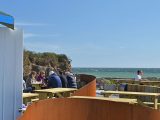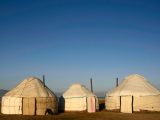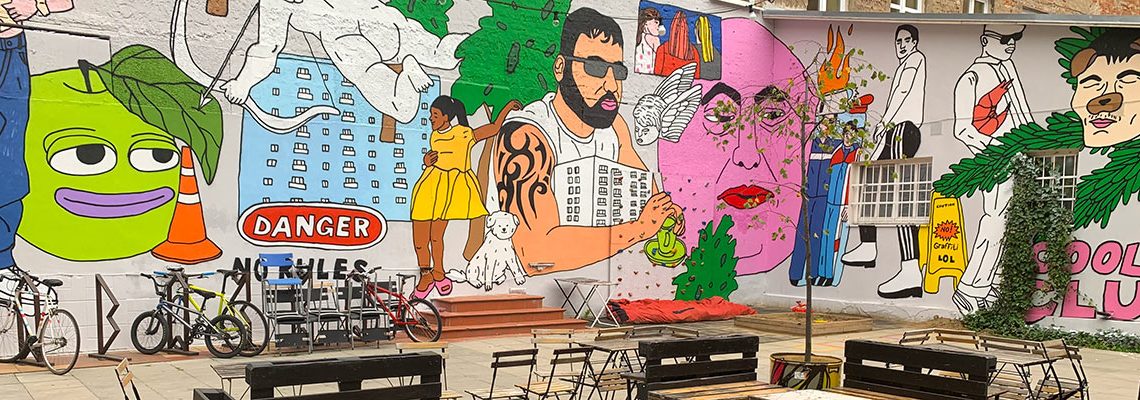
Exploring Central Europe By Train
09/08/2022Driving Communist-era Trabants in Dresden, climbing Bolt Tower in Ostrava (yes, it is named after Usain!) and attending a literary festival in Kosice… Josh Ferry-Woodard journeys to Germany, Czech Republic and Slovakia by train.
Dresden: Dolls & a Trabant Safari
“Anarchists and bohemians made this neighbourhood what it is today,” our guide Christoph explained as we walked through the vibrant streets of Outer Neustadt in Dresden.
The area survived the devastating Allied bombs of 1945, but the grand Wilheminian terraced houses fell into disrepair after the war. It wasn’t until the 80s that artists and squatters moved into the derelict buildings and started to renovate the area.
Fairy lights twinkle in beer gardens, falafel is served from street food shacks, bright murals adorn the walls and the everywhere you look there are people drinking bottles of beer.
Outer Neustadt is the kind of neighbourhood that can make you feel like you’re in Berlin. Fairy lights twinkle in beer gardens, falafel is served from street food shacks, bright murals adorn the walls and the everywhere you look there are people drinking bottles of beer. Needless to say, the streets are lined with cafés, restaurants and cocktail bars – and almost as many bio-markets.
We visited Scheune, a socialist youth centre, which has evolved into an alternative cultural centre that hosts gigs, cabaret, theatre performances, film screenings and club nights.
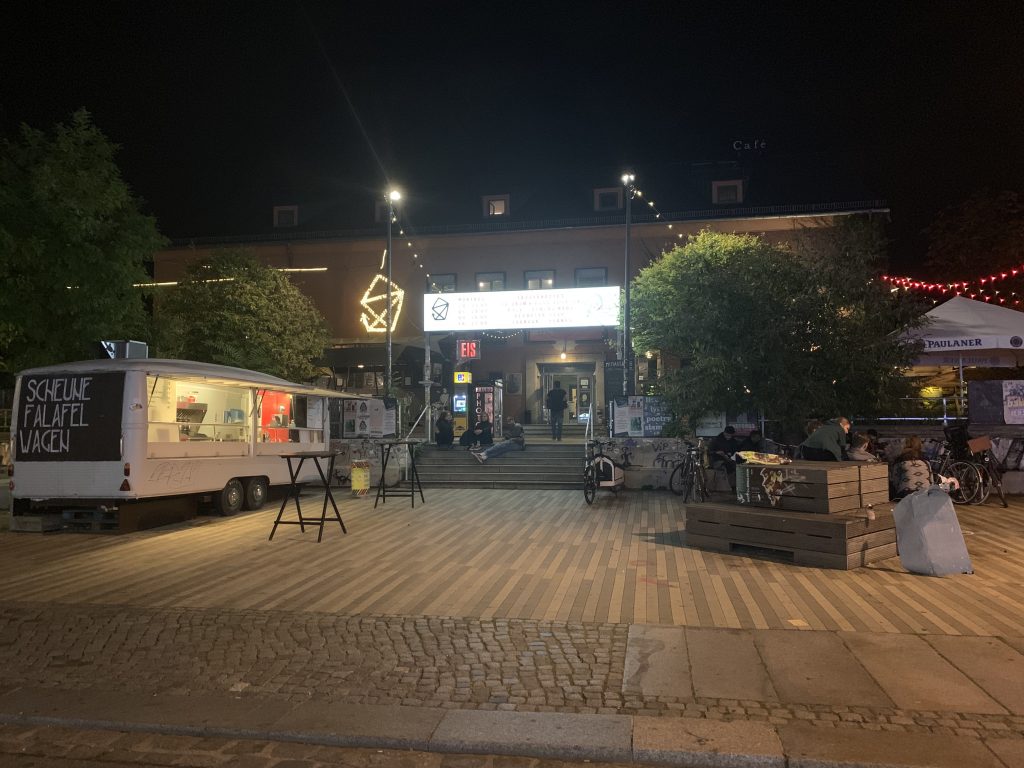
“The city’s favourite cocktail? That would probably be the Caipirinha,” Christoph mused. “They even serve warm Caipirinhas at the Christmas markets!”
Sadly, I didn’t get the chance to sample a warm Caipirinha, but I did pay a visit to the unique Kunsthopassage, a residential courtyard-cum-sculptor gallery where the walls are home to monkeys, giraffes, fairy-tale mosaics and musical drains that sing in the rain.
My favourites were a glorious oversized wooden backgammon set and a spectacular Indian mogul birthday party scene comprised of 137 jewel-encrusted dolls.
The next morning, we strolled into town from the Hotel Am Terrassenufer for a tour of the city centre.
The Inner Altstadt is home to a number of magnificent renaissance and baroque monuments, such as Frauenkirche Church, Neumarkt Square, Zwinger Palace, Semper Opera House and the Royal Palace.
Also known as Dresden Castle, the Royal Palace is home to an extravagant collection of artefacts. My favourites were a glorious oversized wooden backgammon set and a spectacular Indian mogul birthday party scene comprised of 137 jewel-encrusted dolls.
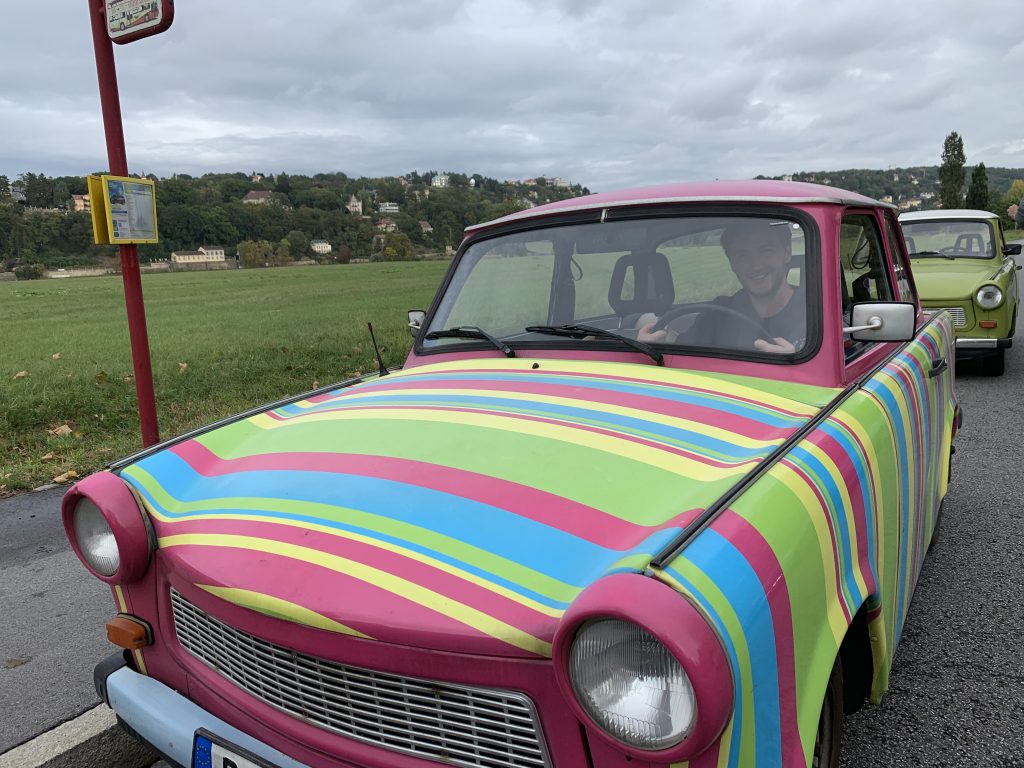
We enjoyed a lunch of cherry tomatoes and garlic butter tagliatelle on board a steamboat before rocking up at Trabi World, to pick up our leopard print and rainbow coloured vintage Trabants.
…we let rip in the iconic Soviet vehicles. The engine roared, bystanders stopped and stared, the whole chassis started shaking… the speedometer barely budged an inch.
After getting to grips with the steering wheel-mounted gearstick, we let rip in the iconic Soviet vehicles. The engine roared, bystanders stopped and stared, the whole chassis started shaking… the speedometer barely budged an inch. But that didn’t matter, our anachronistic ‘safari’ of the city was brilliant fun.
On Track: Slow, Sustainable Travel
Our early morning train to Prague took in beautiful views across the River Elbe, where pine forest lay slightly obscured by the morning mist. The scenic route lasted a few hours before we arrived at the Czech capital where we changed trains and headed towards Ostrava – with big grins on our faces courtesy of some complimentary flutes of sparkling wine.
It’s not an exact science, but the average train journey emits three times less carbon emissions than a flight to the same destination. No wonder the Swedish concept of flygskam (flight shame) is spreading.
Although travelling by train is slower – my journey from London to Dresden took around 12 hours – it is much less impactful on the environment. It’s not an exact science, but the average train journey emits three times less carbon emissions than a flight to the same destination. No wonder the Swedish concept of flygskam (flight shame) is spreading.
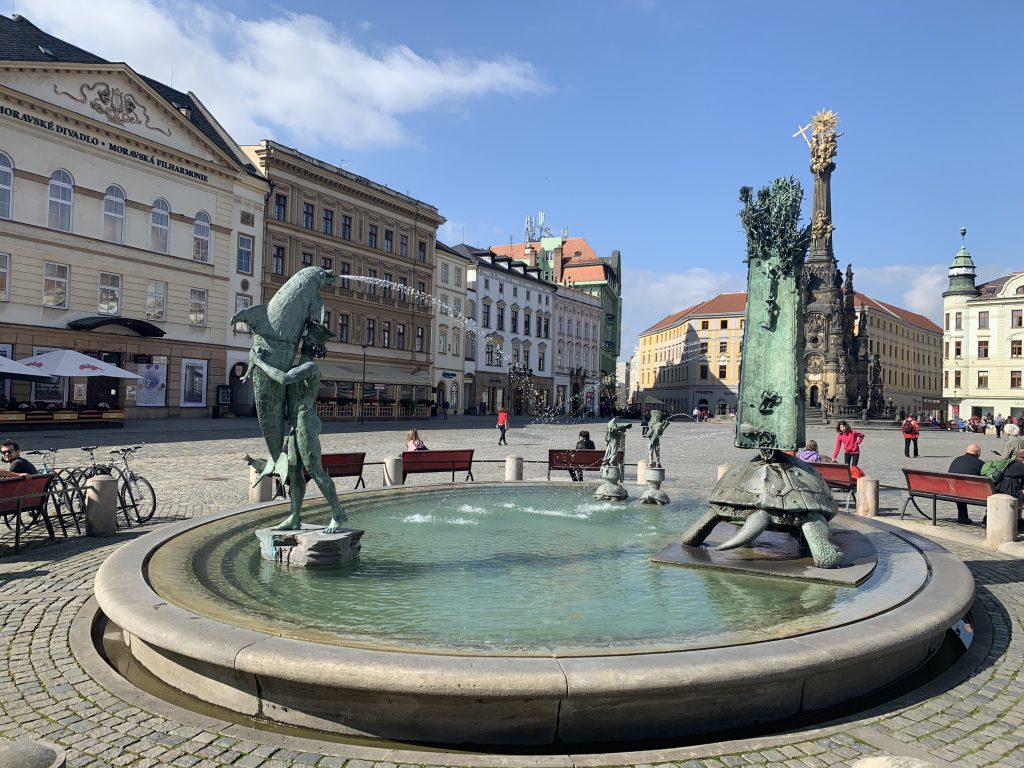
Slower but more sustainable: our train journey was comfortable (legroom: check! table: check! free fake Champagne: check!) and gave us the freedom to explore destinations along the route. We took advantage of this during our connection from Prague to Ostrava and decided to stop in the Medieval city of Olomouc for lunch. (And if you’ve never been to Olomouc, check out Urban Travel Blog’s Long Weekend guide!)
Ostrava: Culture in Unexpected Places
Once known as the ‘Black Heart of the Czech Republic’ the city of Ostrava has undergone profound change over the past two decades. Coal mines and steelworks have shut down, trees have been planted and concerted effort has been made to clean up the city’s reputation.
“I remember how much my mother used to cough from all the pollution in the air when I was younger,” our guide Daniela said as she led us to the entrance of Lower Vitkovice, a 300-hectare, now defunct, industrial site.
“But everything is very different now. Ostrava was even a candidate for the European Green Capital 2020.”
“But everything is very different now. Ostrava was even a candidate for the European Green Capital 2020.”
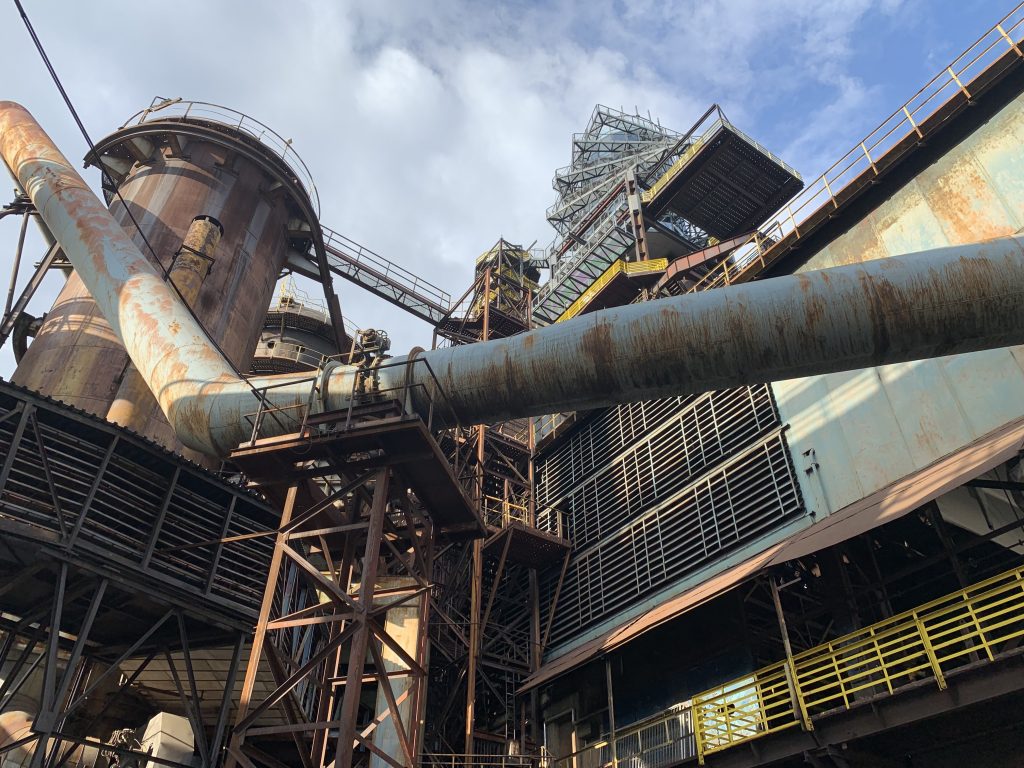
The huge industrial complex is comprised of countless rusted pipes, poles and conduits, creating dramatic shapes and an almost post-apocalyptic landscape. Twisted paint and sculpture exhibits lie scattered around the site.
With the help of a lift we climbed the 71-metre Bolt Tower, named after sprinter Usain Bolt who opened the panoramic pylon in 2015. Pockets of greenery were clearly visible throughout the city, filling the gaps between roads, residential areas and abandoned factories.
With the help of a lift we climbed the 71-metre Bolt Tower, named after sprinter Usain Bolt who opened the panoramic pylon in 2015.
“Lower Vitkovice is now home to many cultural events,” Daniela explained. “There’s an exhibition centre where indie films are shown, a café, a wine bar and a space for gigs. And every year this whole site is home to the Colours of Ostrava music festival.”
Imagining the raucous excitement of 50,000 people partying inside the crazy industrial complex, I made a note to try and persuade my friends to get tickets for 2020.
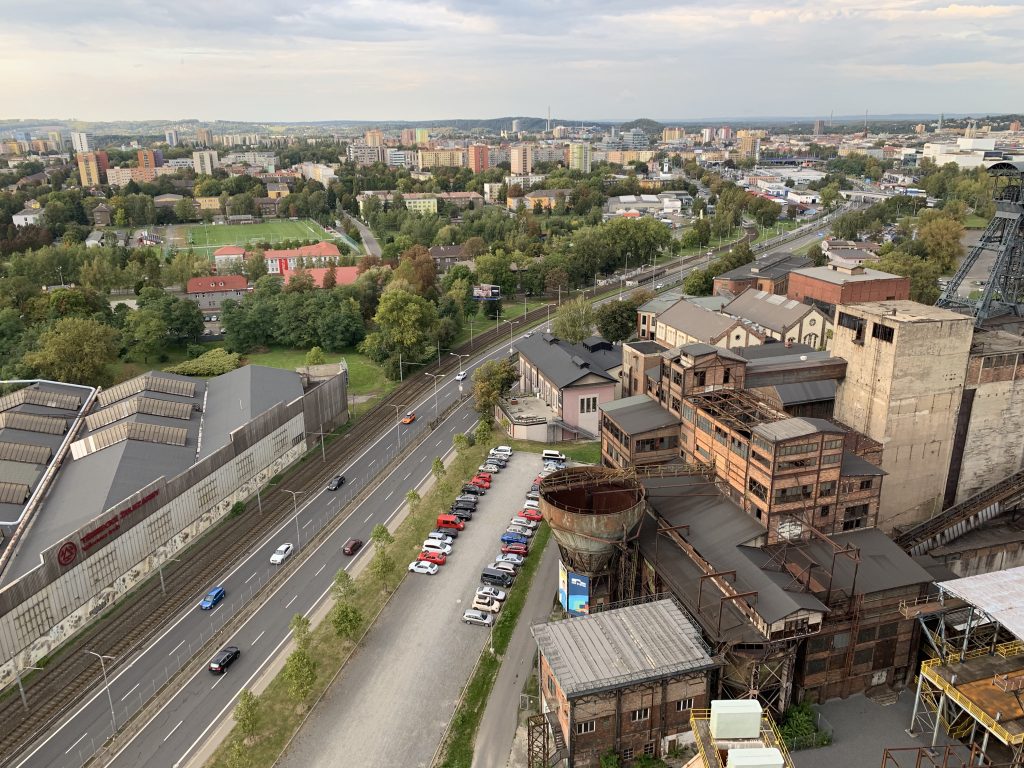
We had dinner at a stylish bistro called Hogo Fogo, where hanging lightbulbs and a living wall attested to Ostrava’s cosmopolitan credentials. I enjoyed a glass of unfiltered Bernard lager and a delicious aged beef roll with rice and rich consommé. Afterwards Daniela pointed out her favourite spots in the city, such as Café Daniel, which lives incongruously on the third floor of a residential block, U Gustava, a speakeasy-style absinthe bar requiring a password for entry and the lively bars of Stodolni Street – known across the Czech Republic as ‘the street that never sleeps.’
The street may not sleep, but it was a long day and I certainly needed some rest. So, after a pint of the world famous Pilsner Urquell I retired to my comfy suite at the Hotel Club Trio.
A Dining Carriage with a View
In the morning I opened my Interrail pass and filled in my journey log for the day’s travel: Ostrava to Zilina and then Zilina to Kosice.
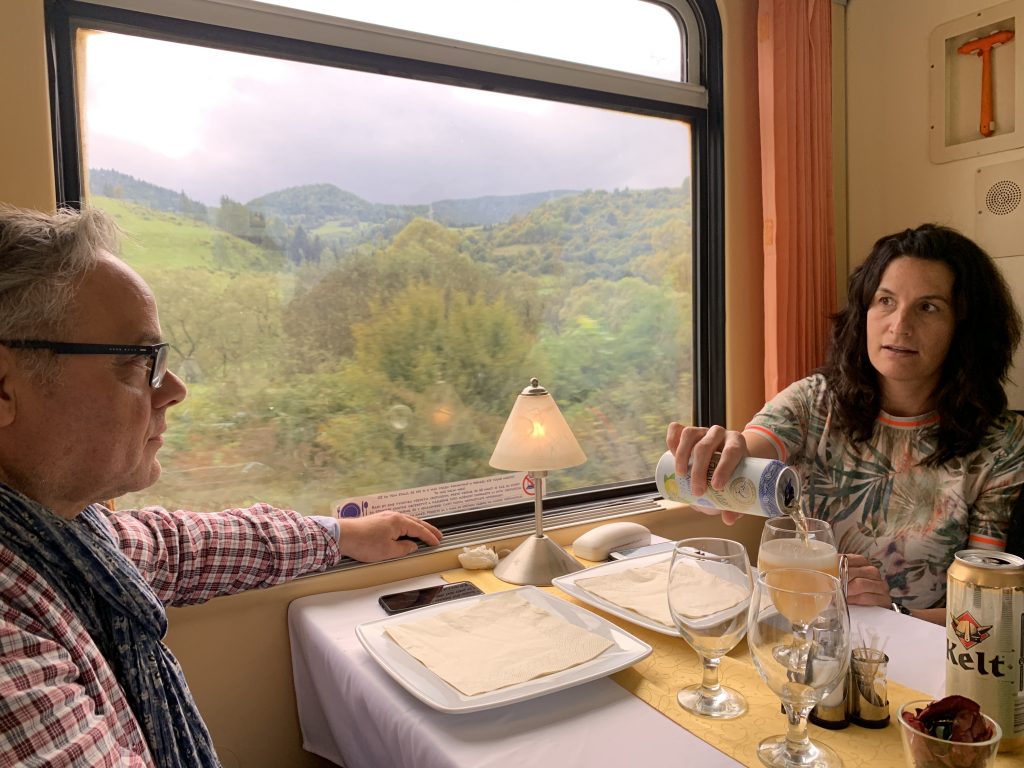
Of all the hundreds of miles of track I covered on the trip, this was the most rousing. We passed picturesque bridges, fast-running rivers and a Medieval castle nestled among the dramatic peaks of the High Tatra mountain range – all from the comfort of the dining carriage with a plate of breaded cheese and a glass of Kelt, Slovakian lager.
We passed picturesque bridges, fast-running rivers and a Medieval castle nestled among the dramatic peaks of the High Tatra mountain range…
There were more beers and Slovakian delicacies on the menu when we arrived in Kosice.
Kosice: Craft Beer & Creative Spaces
Kosice’s quaint old town is clearly demarcated by the city’s medieval walls, while the skyline is dominated by the 59-metre high Gothic St. Elisabeth Cathedral.
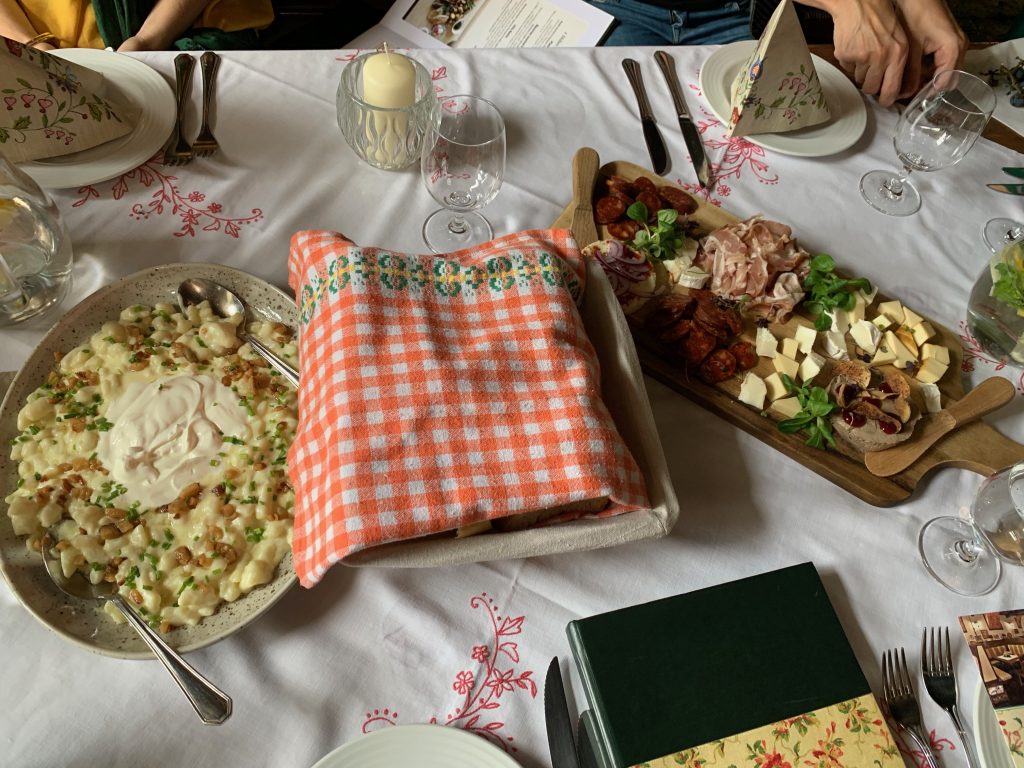
The pedestrianised – and innovatively named – Main Street is home to many of the city’s premier cafés, bars and restaurants. It’s also home to the romantic spectacle of the singing fountains, a beautiful water fountain sandwiched between St Elisabeth and the State Opera House that moves in time to music booming out of speakers in nearby trees. It’s mostly classical music, but I was also privy to an unexpected rendition of East 17’s Stay Another Day.
It’s also home to the romantic spectacle of the singing fountains, a beautiful water fountain sandwiched between St Elisabeth and the State Opera House that moves in time to music booming out of speakers in nearby trees.
“There is actually a DJ, stationed underneath the fountain, who is in charge of all the songs,” our guide Veronika explained as we took the short stroll from Hotel Bristol to Hostinec, a medieval pub.
Operating in some form or another as a restaurant since 1542, Hostinec is the 7th oldest continuously running restaurant in the world. Blessed with an inventory of attractive period fittings, wooden furnishings and evocative stained-glass windows, the craft beer bar is an accomplished marriage of trend and tradition.
“This is our bestseller,” owner and head brewer Peter said, as he filled our goblets with a strong golden ale. “We experiment a lot but this and one other house beer are always on tap upstairs in the bar.”
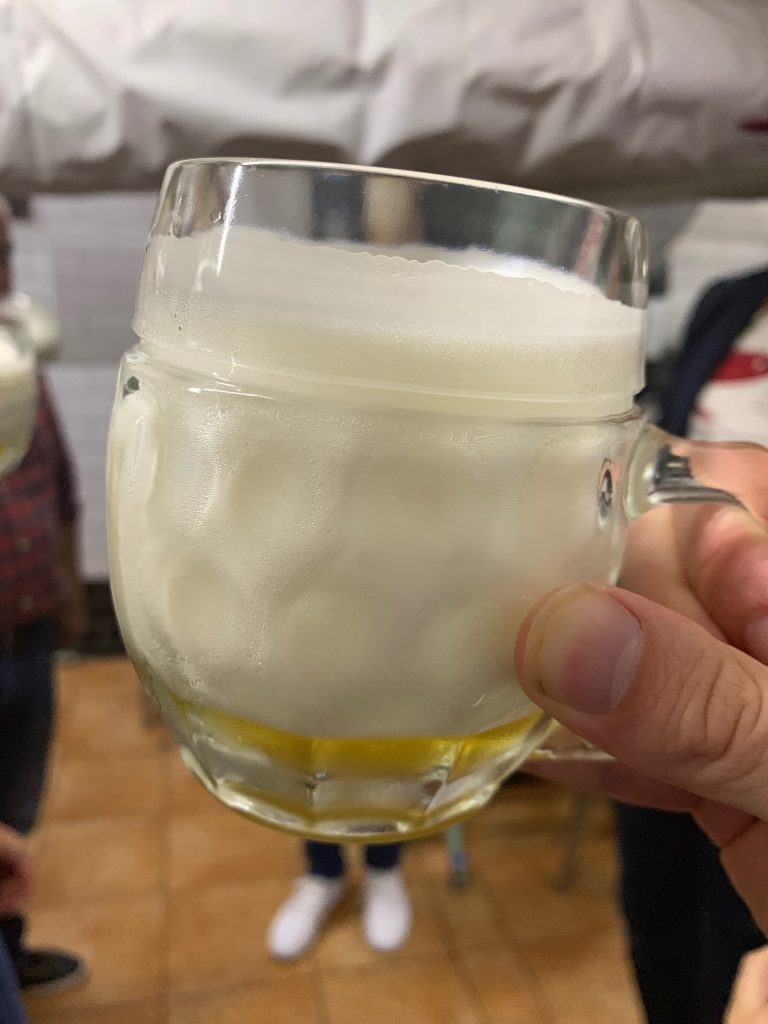
Our tour of the brewery covered how the different ingredients affect the flavour of the beer and culminated in a deliciously comforting sharing plate of beer braised beef, crispy cod, home fries and gooey fried cheese.
After dinner we stopped off for a glass of wine at a tongue-in-cheek, separatist bar. Republic of the East claims independence from Western Slovakia and the influence of capital city Bratislava, but I’m glad to report there were no passport checks at the door.
Cured meats, salty sheep cheese, rich duck-liver pâté, robust garlic soup and a trio of freshly baked breads were served alongside halusky, a Slovakian specialty of potato dumplings smothered in sheep cheese.
The next morning, we climbed the tower at St. Elisabeth Cathedral and viewed the red roofs of the city from above before visiting Villa Regia for a traditional feast. Cured meats, salty sheep cheese, rich duck-liver pâté, robust garlic soup and a trio of freshly baked breads were served alongside halusky, a Slovakian specialty of potato dumplings smothered in sheep cheese. Homemade lavender lemonade and flaming shots of Slivovica accompanied the banquet.
After lunch we stopped in at a literature festival that happened to be taking place at the independent cinema, Kino Usmev, on the way to Tabacka Kulturfabrik.
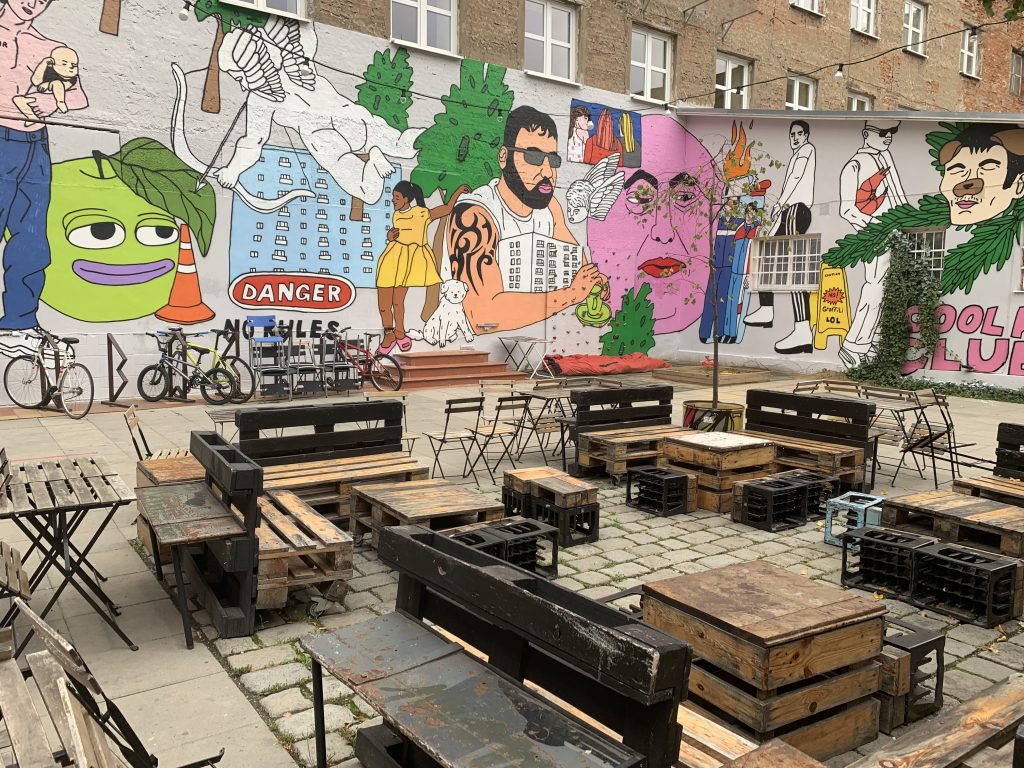
Set in the skeleton of an old tobacco factory, Tabacka is a powerhouse of a cultural centre. Decorated with bright murals and off the cuff pieces of art, it is a one stop shop for all things creative.
“We hold concerts, language cafés, experimental theatre, electro parties, yoga, ecstatic dance, everything really. The space has life of its own,” explained general manager Katarina “It seems to evolve in response to whoever is using it.”
We sampled the locally brewed ‘Moustache Beer’ at the bar and explored the labyrinth of studios, performance areas and co-working spaces. You could easily spend a whole day at Tabacka: coffee on the terrace, lunch and a laptop in the café, catch a performance in the evening and then get to know the local creatives over a beer in the bar – there’s even a hostel on-site.
A Toast to Lesser Known Destinations
On the final night of our Interrail adventure, we visited the atmospheric, candlelit Tokaj Macik wine cellar. The world renowned Tokaji wine region, shared between Hungary and Slovakia, was the first in the world to receive appellation control and is celebrated for its ability to produce extremely sweet wines due to a process known as ‘noble rot.’
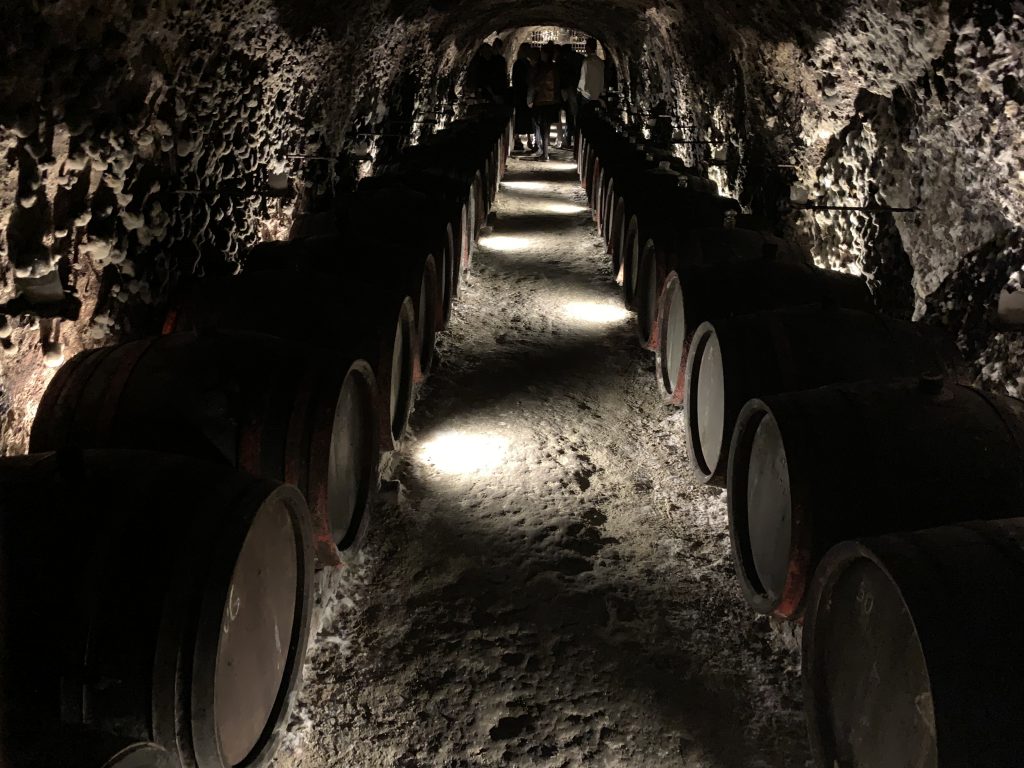
Indeed, many nobles such as Queen Victoria, Beethoven and Goethe have waxed lyrical about the wine over the years, and I must concur: it’s delicious.
During the high-spirited tasting, in which the spit bucket was seldom used, we raised a toast to train travel. A more sustainable way to travel that connects you with brilliant lesser known destinations like Dresden, Ostrava and Kosice.
Josh was invited on this sustainable travel trip by Interrail, in partnership with the tourism boards of Dresden, Ostrava and Kosice. All opinions are his own.

